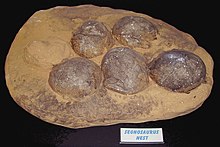Dinosaur egg
The first scientifically recognized non-avian dinosaur egg fossils were discovered in 1923 by an American Museum of Natural History crew in Mongolia.[2][3] In 1859, the first scientifically documented dinosaur egg fossils were discovered in southern France by a Catholic priest and amateur naturalist named Father Jean-Jacques Pouech; he thought, however, that they were laid by giant birds.[4] The first scientifically recognized dinosaur egg fossils were discovered serendipitously in 1923 by an American Museum of Natural History crew while looking for evidence of early humans in Mongolia.[10] Calculi are so egg-like that on one occasion a detailed description of a stomach stone misidentified as a fossil egg was published in the scientific literature.[9] Calculi can be distinguished from real egg fossils because when they are broken open, they show the layers of calcium phosphate and the foreign object at the core.[8] Stomach stones also lack distinct shells with their attending structural components like continuous or prismatic layers, mammillae, and pores.Real egg fossils should preserve eggshell structures like pores, mammillae, and prismatic or continuous layers, which are not present in concretions.After death and burial, the decomposition of a deceased pupa would leave a gap in the sediment that could be filled with minerals carried by groundwater, forming an egg-like cast.[14] Dinosaur eggs further classified by the microstructural aspects of the crystalline structure of the eggshell units and by the type of their pores and their shell ornamentation.In egg-laying amniotes (including dinosaurs), pore canals cutting through the eggshell allow gas exchange between the embryo and the outside world.[26] There are three main categories of dinosaur eggs: spherulitic (sauropods and hadrosaurs),[27] prismatic,[28] and ornithoid (theropods, including modern birds).Typical causes of death include congenital problems, diseases, suffocation from being buried too deep, inimical temperatures, or too much or too little water.Individual pieces of eggshell are much more robust than the entire egg and can be transported intact long distances from where they were originally laid.[58] When the egg is buried deeply enough, the bacteria decomposing it no longer have access to oxygen and need to power their metabolisms with different substances.[57] Generally, however, a fossilizing egg's shell keeps the same calcite it had in life, which allows scientists to study its original structure millions of years after the developing dinosaur hatched or died.When iron-bearing substances alter eggshell it can be obvious because compounds like hematite, pyrite, and iron sulfide can turn the shell blackish or rusty colors.[63] The presence of Oviraptor preserved in their life brooding position suggests that the eggs, nests, and parents may have been rapidly buried by sandstorms.Commercial fossil dealers tend to expose only the bottom of the eggs since the topsides might be damaged by hatching and therefore less visually appealing to potential customers.[67] Even fossilized soft tissue like muscle and cartilage as well as fat globules from the original egg yolk can be uncovered using this method.The exposed bone is then coated with plastic preservatives like Acryloid B67, Paraloid B72, or Vinac B15 to protect it from the acid when submerged for another round.Electricity would then be run through the sample, causing the amino acids to migrate through the gel until they stop at levels determined by their physical properties.These issues cast doubt as to whether the results these sorts of studies give are reliable as the actual composition of the eggshell's organic material in life.However, studies applying these techniques have made suggestive findings, including amino acid profiles in dinosaur eggs similar to those in modern birds.It is most commonly used by opticians to measure lenses but can also be used by paleontologists to estimate the life size of dinosaur eggs from shell fragments.[76] To reconstruct the three-dimensional structures of the shell's pore channels scientists require a series of multiple radial sections.[77] One application of mass spectrometry has been to study the isotope ratios of dinosaur eggshell in order to ascertain their diets and living conditions.X-ray imaging in the context of dinosaur research has generally been used to look for evidence of embryonic fossils contained inside the egg.However, as of Kenneth Carpenter's 1999 book Eggs, Nests, and Baby Dinosaurs, all putative embryos discovered using x-rays have been misidentifications.The fossilized bones will therefore have the same density as the sediment filling the interior of the egg which served as the source for their mineral content and will be poorly visible in an x-ray image.So far the only reliable method for examining embryonic fossils preserved in dinosaur eggs is to physically extract them through means such as acid dissolution.




sauropodIndroda Dinosaur and Fossil ParkdinosaurEnglandreptilesFrancebird eggsAmerican Museum of Natural HistoryMongoliathin sectionmicroscopeCAT scansembryoMassospondylusEarly JurassicTimeline of egg fossil researchCitipatiCatholic priestserendipitouslyearly humansProtoceratopsOviraptormammillaeruminantscattlecalcium phosphatepathological eggsConcretionsprecipitatingamnionchorionallantoisMegaloolithuselephant birdcalcium carbonatePreprismatoolithusturtlescrocodylianssenior thesisPrinceton UniversitymegaloolithidsanastomosinghadrosaursprismatictheropodsOogeneraTherizinosaurSegnosaurusDinosaurlandLyme RegisAgeroolithusApheloolithusBoletuoolithusCairanoolithusContinuoolithusDendroolithusDictyoolithusDispersituberoolithusEllipsoolithusElongatoolithusFaveoolithusHeishanoolithusLaevisoolithusMacroolithusMacroelongatoolithusNanshiungoolithusOblongoolithusOvaloolithusPachycorioolithusParaspheroolithusPhaceloolithusPorituberoolithusPolyclonoolithusPrismatoolithusProtoceratopsidovumPseudogeckoolithusShixingoolithusSphaerovumSpheroolithusStromatoolithusSubtiliolithusTacuarembovumTrachoolithusTristraguloolithusYoungoolithusontogenyheterochronysystematicsBeibeilongHeyuanniaHypacrosaurusLufengosaurusLourinhanosaurusMaiasauraQianlong shouhuTroodonEgg taphonomysuffocationdiagenesishematitepyriteiron sulfideBeach sandsFloodplainsmudstonesSand dunespneumaticX-Actoacetic acidegg yolkTerry ManningParaloid B72mineralizedCathodoluminescencecalciumGel electrophoresisamino acidsProtein silver stainopticiansdioptersLight microscopyPaul Gervaisemery papertranslucentcalcite crystalspetrographic microscope
